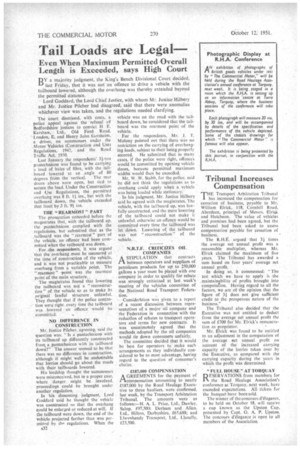Tail Loads are Legal
Page 34

If you've noticed an error in this article please click here to report it so we can fix it.
Even When Maximum Permitted Overall Length is Exceeded, says High Court
ply a majority judgment, the King's Bench Divisional Court decided, " last Friday, that it was not an offence to drive a vehicle with the tailboard lowered, although the overhang was thereby extended beyond the permitted distance.
• Lord Goddard. the Lord Chief Justice, with whom Mr, Justice Hilbery and Mr. Justice Pitcher had disagreed, said that there were anomalies whichever view was taken, and the regulations needed clarifying.
The court dismissed, with costs, a Police appeal against the refusal of Bedfordshire justices to convict H l. Kershaw, Ltd., Old Ford Road, London, E, and Henry John Gotsheim, a driver, on summonses under the Motor Vehicles (Construction and Use) Regulations, 1947, and the Road
raffle Act. 1930.
Last January the respondents 31-ton pantechnicon was found to be carrying a load of bales -tif fibre, with the tailboard lowered at an .angle of 80
degrees from the vertical. The rear doors above were open, but tied to secure the load. Under the Construction and 'Use Regulations, the permitted overhang was 8 ft. 11 ins:, but with the tailboard down, the vehicle exceeded that limit by 3 ft. 91 ins.
THE " REARMOST " PART
The prosecution conceded before the magistrates that, with the tailboard up. the pantechnicon complied with the -regulations, but submitted that as the ;tailboard was the "rearmost" part of the vehicle, an offence had been committed when the tailboard was down.
For-the tmesporiderits, it was argued that the overhang must be Measured at the time of construction of the vehicle, and it was not practicable to measure overhang from a variable point. The " rearmost " point was the rearmost pant of the main structure., The magistrates found that lowering the 'tailboard was not a " reConstrtic,tion" of the vehicle, so as to make its original lawful structure unlawful. They thought that if the police contention were right, every time the tailboard was lowered an offence would be _commi t ted.
NO _DIFFERENCE IN . CONSTRUCTION Mr. Justice Pitcher, agreeing. said the question was: Is a pantechnicon with its tailboard up differently constructed from, a pantechnicon with its tailboard down?" The answer seemed to be that there was no difference in construction. although it might well be _undesirable that lorries should go about the roads with their tailboards lowered.
His lordship thought the summonses were misconceived, but in a proper caSti, where danger might be involved, proceedings could be brought under another regulation. .
In his dissenting judgment, Lord Goddard said he thought the vehicle was constructed so that the overhang could be enlarged or reducedsat wilt If the tailboard were down, the end of the vehicle projected farther than was permitted by the regulations. When the
A32 vehicle was on the road with the tailboard down, he considered that the tailboard was the rearmost point of the vehicle.
For the respondents, Mr. J. T: Molony pointed out that there was no restriction on the carrying of overhanging loads, subject to their being properly secured. He submitted that in many cases, if the police were right, offences would be committed by opening vehicle doors, because permitted maximum widths would then be exceeded.
Mr. W. W. Stabb, for the police, said he did not think the regulations as to overhang could apply when a vehicle was being loaded while stationary.
In his judgment, Mr. Justice Hilbery said he agreed with the magistrates. The vehicle, with the tailboard up, was lawfully constructed, and the mere lowering of the tailboard could not make it unlawful. otherwise an offence would be committed every time the tailboard was let dciwn. Lowering of, the tailboard was not " reconstruction " of the vehicle.
N.R.T.F. CRITICIZES OIL COMPANIES .
A STIPULATION that contracts .1-1 between operators and suppliers of petreleum :products for up to 250,000 gallons a year must be Placed with one company in Order to qualify for rebate was strongly criticized at last week's meeting of the vehicles committee of the National Road Transport Federation.
Considerlation was given to a report
of a recent discussion between representatives of a major.oil company and the Federation in connection with -the reduction of rebates to transport operators and terms for new contracts. It Was unanimonsly agreed that the methods adopted by the oil companies
• would tie down consumers unfairly. The committee decided that it would be best for operators to make such arrangements as they individually considered to be to most advantage, having regard to the question of consumer's etio:ce.
£187,000 COMPENSATION
AGREEMENTS for the payment of compensation amounting to nearly £187,000 by the Road Haulage Executive to three hauliers, were confirmed. last week, by the Transport Arbitration Tribunal. The amounts were as follows:—H. A. L. Price, Ltd., Dawley. Salop, £97,500; Derhann and Allen. Ltd., Hilton, Derbyshire, £65,688; and LIwynhendy Transport, Ltd., Llanelly, £23,00.




















































































